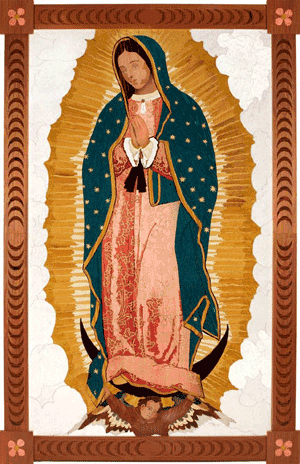Any traveler to Mexico will soon become familiar
with an image not only prevalent in murals and churches, but also in
roadside shrines, restaurants, automobile decals—just about everywhere
you turn. The image is the Virgin of Guadalupe, and to the Mexican people,
she is a sacred icon for both Catholic faith and nationalism.
The Nican Mopohua (“Now it is Told”) is regarded as the seminal
work describing the appearance of the icon in the New World. Written
in the native Nahuatl language, the book describes the meetings between
The Virgin and an Indian, Juan Diego (since 2002, Saint Juan Diego).
In 1531, at Tepeyac, a barren hill outside of what is now Mexico City,
a vision of a “lady of heaven” appeared to Juan Diego and
requested that a church be built on the desolate mountaintop. She sent
him to Bishop Zumárraga who demanded that Juan Diego bring back
a sign from her. Our Lady complied, ordering Juan Diego to gather an
assortment of Castillian roses from the mountain. Not only was it the
middle of December, but roses did not thrive in the rocky soil. Miraculously,
they were found growing there. Juan Diego collected the roses in his
tilma—a cloth woven from the fibers of the agave cactus. The Lady
arranged the roses in Juan Diego’s cloak, then wrapped them, explaining
that he should not open the parcel until he returned to the bishop. Upon
delivery it was found that the roses, still fresh with the scent of morning
dew, were accompanied by an image of the Lady stained into the tilma.
The Bishop was moved, and ordered the construction of the church.
Besides the religious significance, the icon was also a powerful symbol
of both the Mexican War of Independence
and the Mexican Revolution. In 1810, Miguel Hidalgo sounded the cry for
independence, when he declared “death to the Spaniards and long
live the Virgin of Guadalupe!” He and his men wore hats with the
Virgin’s image emblazoned on them. One hundred years later, Emiliano
Zapata and his men carried Guadalupan Banners as they stormed into Mexico
City.
The tilma, now housed in the new Basilica of Our Lady of Guadalupe on
Tepeyac Hill in Mexico City, has not deteriorated in almost five centuries
despite exposure to temperature changes, humidity, incense and candle
smoke, and the kisses of thousands of those paying homage.
In 1791, a silversmith, cleaning the frame, spilled highly corrosive
nitric acid on the tilma but it left only a small stain that is fading
with time. In 1921, a factory worker laid explosives near the icon which
cracked the steps of the main alter, shattered neighboring windows and
dismantled a brass crucifix. Despite the blast, the fabric was unharmed.
Since then, the icon is kept behind bulletproof glass and moved to a
vault every night.
Throughout the years the tilma has been studied by scientists who put
forth various theories, but Our Lady of Guadalupe still mystifies the
estimated 14 million people who visit her basilica annually and make
her home in Mexico City the most visited Marian shrine as well as most
popular catholic sanctuary in the world.
Click Here for information on our Copper Canyon Tours.



